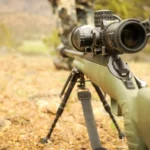Table of Contents
Read the rest of the article to learn my take on the buckshot vs slug for hunting debate.
Shotguns can be extremely effective for big game hunting if they’re used correctly. For those who hunt big game with a shotgun, it is important to weigh the advantages and disadvantages of using buckshot or a slug. The buckshot vs slug debate has been raging for many years. While I won’t settle that question during the course of this article, I will discuss the pros and cons of hunting with buckshot vs a slug and hopefully provide some good advice for prospective hunters.
Note: some of the links below are affiliate links. This means I will earn a small commission (at no extra cost to you) if you make a purchase. This helps support the blog and allows me to continue to create free content that’s useful to hunters like yourself. Thanks for your support.
Buckshot
Buckshot is the largest type of “shot” loaded in shotgun shells and a typical buckshot load consists of multiple medium diameter pellets. There are many different types and variations of buckshot currently in use, but 12 gauge “00” (“double-aught”) buckshot consisting of 9 (sometimes more) .33 caliber pellets, is the most common. As the name would suggest, buckshot was originally designed for use on medium-sized species of game such as deer.
Like all types of shot, a buckshot pattern grows in size as the range increases. To a certain extent, this is good because it gives the hunter a little room for error when aiming. However, this also means that buckshot has a relatively short maximum effective range. Depending on the exact shotgun and buckshot load being used, you’re probably looking at a maximum range of around 30 yards.
Another disadvantage of using buckshot is the fact that since the individual pellets are normally relatively lightweight (a lead 00 buckshot pellet weighs 50-51 grains), they do not retain their energy or penetrate as well as slugs. This also limits the effectiveness of buckshot on thick-skinned animals and at longer ranges.
That being said, buckshot is absolutely devastating when used at close range on thin-skinned game. The characteristics of buckshot also make it extremely effective for shooting at moving animals.
For that reason, buckshot is very popular among hunters pursuing deer with hounds and by guides in Africa following up wounded leopards. As long as it is used under appropriate conditions, buckshot is an excellent, though not very versatile choice.
BUY SOME GREAT 12 GAUGE BUCKSHOT AMMO HERE
BUY SOME QUALITY 20 GAUGE BUCKSHOT AMMO HERE
Slug
In direct contrast to buckshot is a slug, which is a single, large diameter projectile designed to be fired from a shotgun. Just like buckshot, there are many different types of shotgun slugs available on the market. While there are numerous differences between the various types of slugs, they all share several basic characteristics in performance.
The big advantage of using a slug is that it has a much longer effective range than buckshot. A 50-75 yard shot on a deer is usually well within the performance capability of a shotgun shooting slugs. When using a barrel designed to shoot slugs and more precise iron sights or a scope, this range can be extended even further.
Though a shotgun shooting slugs will not even come close to matching the effective range of most centerfire rifles, it can easily be used to take ethical shots on animals 2-3x further away than a shotgun shooting buckshot.
Additionally, since a slug is a single large diameter projectile, it makes a very big hole in whatever it hits. Though the exact size of the projectile varies, at .615 caliber, a 20 gauge slug is approximately twice the diameter of a .30-06 bullet and a 12 gauge slug (.729 caliber) is even larger.
Shotgun slugs are also usually very heavy: a 3/4 ounce (328 gr) 20 gauge slug and a 1 ounce (437.5 gr) 12 gauge slug are both significantly heavier than a 150 gr .30-06 bullet. Additionally, shotgun slugs retain their energy better and typically penetrate much deeper than buckshot.
A shotgun shooting a slug is also much more precise than a shotgun shooting buckshot. Depending on the situation, this can be either a good or a bad thing. However, this means the hunter has less margin for error when aiming, which is especially apparent when shooting at a moving target.
BUY SOME GREAT 12 GAUGE SLUGS HERE
BUY SOME GREAT 20 GAUGE SLUGS HERE
Buckshot vs Slug
So what should you use: buckshot or a slug?
Well, it depends on the animal being hunted, the circumstances of the hunt, and the local hunting regulations. It is not legal to hunt big game with buckshot in many places, probably due to the fact that so many hunters wound and lose deer by shooting them with buckshot at too long of a range.
If this is the case where you hunt, the choice is simple: use a slug.
For the majority of hunters, using a slug is probably the best choice due to the superior range and flexibility of the slug vs buckshot.
However, if you hunt thin-skinned game (like deer) in an area where you are likely to only take extremely short range shots and where it is legal to do so, then use buckshot.
For a more detailed discussion on the different shotgun gauges and their recommended uses, read the article below:
Shotgun Gauges Explained: 10 vs 12 vs 16 vs 20 vs 28 vs 410
Make sure you follow The Big Game Hunting Blog on Facebook, Instagram, Twitter, and YouTube.










































